| The Metropolitan Museum of Art | |
|---|---|
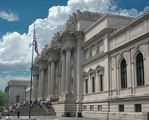 | |
| | |
| Established | 1870[1][2] |
| Location | 5th Avenue and 82nd Street, Manhattan, New York |
| Visitor figures | 5.2 million (2008)[1]
|
| Director | Thomas P. Campbell |
| Public transit access | 86th Street (IRT Lexington Avenue Line) |
| Website | http://www.metmuseum.org/ |
| The Metropolitan Museum of Art | |
|---|---|
| U.S. National Register of Historic Places | |
| U.S. National Historic Landmark | |
| Elevation by Simon Fieldhouse | |
| Built: | 1874 |
| Architect: | Calvert Vaux; Jacob Wrey Mould |
| Architectural style(s): | Beaux-Arts |
| Governing body: | Local |
| Added to NRHP: | January 29, 1972[4] |
| Designated NHL: | June 24, 1986[5] |
| NRHP Reference#: | 86003556 |
The Metropolitan Museum of Art, known colloquially as The Met, is an art museum located on the eastern edge of Central Park, along what is known as Museum Mile in New York City, USA. Its permanent collection contains more than two million works of art, divided into nineteen curatorial departments.[6] The main building, often referred to simply as "the Met", is one of the world's largest art galleries; there is also a much smaller second location in Upper Manhattan, at "The Cloisters", which features medieval art.[7]
Represented in the permanent collection are works of art from classical antiquity and Ancient Egypt, paintings and sculptures from nearly all the European masters, and an extensive collection of American and modern art. The Met also maintains extensive holdings of African, Asian, Oceanic, Byzantine, and Islamic art.[8] The museum is also home to encyclopedic collections of musical instruments, costumes and accessories, and antique weapons and armor from around the world.[9] A number of notable interiors, ranging from 1st century Rome through modern American design, are permanently installed in the Met's galleries.[10]
The Metropolitan Museum of Art was founded in 1870 by a group of American citizens. The founders included businessmen and financiers, as well as leading artists and thinkers of the day, who wanted to open a museum to bring art and art education to the American people.[2] It opened on February 20, 1872, and was originally located at 681 Fifth Avenue.[11]
As of 2007, the Met measures almost 1&fras1;4-mile (400 m) long and occupies more than 2,000,000 square feet (190,000 m2).[12]
Collections

The Met's permanent collection is cared for and exhibited by seventeen separate curatorial departments, each with a specialized staff of curators and scholars, as well as four dedicated conservation departments and a department of scientific research.[6]
Represented in the permanent collection are works of art from classical antiquity and Ancient Egypt, paintings and sculptures from nearly all the European masters, and an extensive collection of American and modern art. The Met also maintains extensive holdings of African, Asian, Oceanic, Byzantine and Islamic art.[8] The museum is also home to encyclopedic collections of musical instruments, costumes and accessories, and antique weapons and armor from around the world.[9] A number of notable interiors, ranging from 1st century Rome through modern American design, are permanently installed in the Met's galleries.[10]
In addition to its permanent exhibitions, the Met organizes and hosts large traveling shows throughout the year.[13]
At present (January 2009), the director of the museum is Thomas P. Campbell, a long-time curator, who replaced Philippe de Montebello following his retirement at the end of 2008.[14][15]
American decorative arts
The American Decorative Arts Department includes about 12,000 examples of American decorative art, ranging from the late 17th to the early 20th centuries. Though the Met acquired its first major holdings of American decorative arts via a 1909 donation by Margaret Olivia Slocum Sage, wife of the financier Russell Sage, a decorative arts department specifically dedicated to American works was not established until 1934. One of the prizes of the Department is its extensive collection of American stained glass. This collection, probably the most comprehensive in the world, includes many pieces by Louis Comfort Tiffany, Henry E. Sharp, William Jay Bolton, and John LaFarge. The Department maintains twenty-five period rooms in the museum, each of which recreates an entire room, complete with furnishings, from a noted period or designer. The Department's current holdings also include an extensive silver collection notable for numerous pieces by Paul Revere as well as Tiffany & Co.[citation needed]
American paintings and sculpture
Since its founding, the Metropolitan Museum of Art has placed a particular emphasis on collecting American art. The first piece to enter the Met's collection was an allegorical sculpture by Hiram Powers titled California, acquired in 1870, which can still be seen in the Met's galleries today. In the following decades, the Met's collection of American paintings and sculpture has grown to include more than one thousand paintings, six hundred sculptures, and 2,600 drawings, covering the entire range of American art from the early Colonial period through the early 20th century. Many of the best-known American paintings are held in the Met's collection, including a portrait of George Washington by Gilbert Stuart and Emanuel Leutze's monumental Washington Crossing the Delaware. The collection also includes masterpieces by such notable American painters as Winslow Homer, George Caleb Bingham, John Singer Sargent, James McNeill Whistler, and Thomas Eakins.[citation needed]
Ancient Near Eastern art
Beginning in the late 19th century, the Met started to acquire ancient art and artifacts from the Near East. From a few cuneiform tablets and seals, the Met's collection of Near Eastern art has grown to more than 7,000 pieces. Representing a history of the region beginning in the Neolithic Period and encompassing the fall of the Sassanian Empire and the end of Late Antiquity, the collection includes works from the Sumerian, Hittite, Sassanian, Assyrian, Babylonian and Elamite cultures (among others), as well as an extensive collection of unique Bronze Age objects. The highlights of the collection include a set of monumental stone lammasu, or guardian figures, from the Northwest Palace of the Assyrian king Ashurnasirpal II.[7]
Arms and armor
The Met's Department of Arms and Armor is one of the museum's most popular collections. The distinctive "parade" of armored figures on horseback installed in the first-floor Arms and Armor gallery is one of the most recognizable images of the museum. The department's focus on "outstanding craftsmanship and decoration", including pieces intended solely for display, means that the collection is strongest in late medieval European pieces and Japanese pieces from the 5th through the 19th centuries. However, these are not the only cultures represented in Arms and Armor; the collection spans more geographic regions than almost any other department, including weapons and armor from dynastic Egypt, ancient Greece, the Roman Empire, the ancient Near East, Africa, Oceania, and the Americas, as well as American firearms (especially Colt firearms) from the 19th and 20th centuries. Among the collection's 15,000 objects are many pieces made for and used by kings and princes, including armor belonging to Henry VIII of England, Henry II of France and Ferdinand I of Germany.
Arts of Africa, Oceania, and the Americas
Though the Met first acquired a group of Peruvian antiquities in 1882, the museum did not begin a concerted effort to collect works from Africa, Oceania, and the Americas until 1969, when American businessman and philanthropist Nelson A. Rockefeller donated his more than 3,000-piece collection to the museum. Today, the Met's collection contains more than 11,000 pieces from sub-Saharan Africa, the Pacific Islands and the Americas and is housed in the 40,000-square-foot (4,000 m2) Rockefeller Wing on the south end of the museum. The collection ranges from 40,000-year-old Australian Aboriginal rock paintings, to a group of 15-foot-high (4.6 m) memorial poles carved by the Asmat people of New Guinea, to a priceless collection of ceremonial and personal objects from the Nigerian Court of Benin donated by Klaus Perls.[16] The range of materials represented in the Africa, Oceania, and Americas collection is undoubtedly the widest of any department at the Met, including everything from precious metals to porcupine quills.
Asian art
The Met's Asian department holds a collection of Asian art that is arguably the most comprehensive in the US. The collection dates back almost to the founding of the museum: many of the philanthropists who made the earliest gifts to the museum included Asian art in their collections. Today, an entire wing of the museum is dedicated to the Asian collection, which contains more than 60,000 pieces and spans 4,000 years of Asian art. Every Asian civilization is represented in the Met's Asian department, and the pieces on display include every type of decorative art, from painting and printmaking to sculpture and metalworking. The department is well-known for its comprehensive collection of Chinese calligraphy and painting, as well as for its Nepalese and Tibetan works. However, not only "art" and ritual objects are represented in the collection; many of the best-known pieces are functional objects. The Asian wing even contains a complete Ming Dynasty-style Astor garden court, modeled on a courtyard in the Garden of the Master of the Fishing Nets in Suzhou.
The Costume Institute
The Museum of Costume Art was founded by Aline Bernstein and Irene Lewisohn.[17] In 1937 they merged with the Met and became its Costume Institute department. Today, its collection contains more than 80,000 costumes and accessories. The Costume Institute used to have a permanent gallery space in what was known as the "Basement" area of the Met because it was downstairs at the bottom of the Met facility. However, due to the fragile nature of the items in the collection, the Costume Institute does not maintain a permanent installation. Instead, every year it holds two separate shows in the Met's galleries using costumes from its collection, with each show centering on a specific designer or theme. In past years, Costume Institute shows organized around famous designers such as Cristóbal Balenciaga, Chanel, Yves Saint Laurent (designer), and Gianni Versace; and style doyenne like Diana Vreeland, Jacqueline Kennedy Onassis, Nan Kempner and Iris Apfel have drawn significant crowds to the Met. The Costume Institute's annual Benefit Gala, co-chaired by Vogue editor-in-chief Anna Wintour, is an extremely popular, if exclusive, event in the fashion world; in 2007, the 700 available tickets started at $6,500 per person.[18]
Drawings and prints
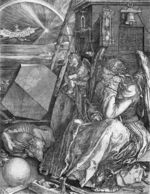
Though other departments contain significant numbers of drawings and prints, the Drawings and Prints department specifically concentrates on North American pieces and western European works produced after the Middle Ages. Currently, the Drawings and Prints collection contains more than 11,000 drawings, 1.5 million prints, and twelve thousand illustrated books. The collection has been steadily growing ever since the first bequest of 670 drawings donated to the museum by Cornelius Vanderbilt in 1880. The great masters of European painting, who produced many more sketches and drawings than actual paintings, are extensively represented in the Drawing and Prints collection. The department's holdings contain major drawings by Michelangelo, Leonardo da Vinci, and Rembrandt, as well as prints and etchings by Van Dyck, Dürer, and Degas among many others.
Egyptian art
Though the majority of the Met's initial holdings of Egyptian art came from private collections, items uncovered during the museum's own archeological excavations, carried out between 1906 and 1941, constitute almost half of the current collection. More than 36,000 separate pieces of Egyptian art from the Paleolithic era through the Roman era constitute the Met's Egyptian collection, and almost all of them are on display in the museum's massive wing of 40 Egyptian galleries. Among the most valuable pieces in the Met's Egyptian collection are 13 wooden models (of the total 24 models found together, 12 models and 1 offering bearer figure is at the Met, while the remaining 10 models and 1 offering bearer figure are in the Egyptian Museum in Cairo), discovered in a tomb in the Southern Asasif in western Thebes in 1920. These models depict, in unparalleled detail, a cross-section of Egyptian life in the early Middle Kingdom: boats, gardens, and scenes of daily life are represented in miniature. However, the popular centerpiece of the Egyptian Art department continues to be the Temple of Dendur. Dismantled by the Egyptian government to save it from rising waters caused by the building of the Aswan High Dam, the large sandstone temple was given to the United States in 1965 and assembled in the Met's Sackler Wing in 1978. Situated in a large room, partially surrounded by a reflecting pool and illuminated by a wall of windows opening onto Central Park, the Temple of Dendur is one of the Met's most enduring attractions. The oldest items at the Met, a set of Archeulian flints from Deir el-Bahri which date from the Lower Paleolithic period (between 300,000 - 75,000 BC), are part of the Egyptian collection.
European paintings
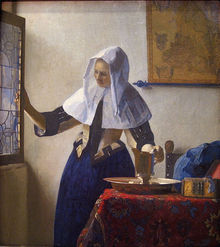
Though the Met's collection of European paintings numbers only around 2,200 pieces, it contains many of the world's most instantly recognizable paintings. The bulk of the Met's purchasing has always been in this department, primarily focusing on Old Masters and 19th century European paintings, with an emphasis on French, Italian and Dutch artists. Many great artists are represented in remarkable depth in the Met's holdings: the museum owns thirty-seven paintings by Monet, twenty-one oils by Cézanne, and eighteen Rembrandts including Aristotle With a Bust of Homer. The Met's five paintings by Vermeer represent the largest collection of the artist's work anywhere in the world. Other highlights of the collection include Van Gogh's Self-Portrait with a Straw Hat, Pieter Bruegel the Elder's The Harvesters, Georges de La Tour's The Fortune Teller, El Greco's View of Toledo, Raphael's Colonna Altarpiece, Botticelli's Last Communion of St Jerome, and Jacques-Louis David's The Death of Socrates. In recent decades, the Met has carried out a policy of deaccessioning its "minor" holdings in order to purchase a smaller number of "world-class" pieces. Though this policy remains controversial, it has gained a number of outstanding (and outstandingly expensive) masterpieces for the European Paintings collection, beginning with Velázquez's Juan de Pareja in 1971. A more recent purchase is Duccio's Madonna and Child, which cost the museum more than $45 million, more than twice the amount it had paid for any previous painting. The painting itself, which is only slightly larger than 9 by 6 inches (23 by 15 cm), has been called "the Met's Mona Lisa".[citation needed]
European sculpture and decorative arts
The European Sculpture and Decorative Arts collection is one of the largest departments at the Met, holding in excess of 50,000 separate pieces from the 15th through the early 20th centuries. Though the collection is particularly concentrated in Renaissance sculpture—much of which can be seen in situ surrounded by contemporary furnishings and decoration—it also contains comprehensive holdings of furniture, jewelry, glass and ceramic pieces, tapestries, textiles, and timepieces and mathematical instruments. Visitors can enter dozens of completely furnished period rooms, transplanted in their entirety into the Met's galleries. The collection even includes an entire 16th century patio from the Spanish castle of Vélez Blanco, reconstructed in a two-story gallery. Sculptural highlights of the sprawling department include Bernini's Bacchanal, a cast of Rodin's The Burghers of Calais, and several unique pieces by Houdon, including his Bust of Voltaire and his famous portrait of his daughter Sabine.
Greek and Roman art
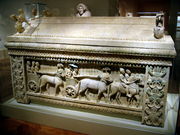
The Met's collection of Greek and Roman art contains more than 35,000[19] works dated through AD 312. The Greek and Roman collection dates back to the founding of the museum—in fact, the museum's first accessioned object was a Roman sarcophagus, still currently on display. Though the collection naturally concentrates on items from ancient Greece and the Roman Empire, these historical regions represent a wide range of cultures and artistic styles, from classic Greek black-figure and red-figure vases to carved Roman tunic pins. Several highlights of the collection include the Euphronios krater depicting the death of Sarpedon (whose ownership has since been transferred to the Republic of Italy), the monumental Amathus sarcophagus, and a magnificently detailed Etruscan chariot known as the "Monteleone chariot". The collection also contains many pieces from far earlier than the Greek or Roman empires—among the most remarkable are a collection of early Cycladic sculptures from the mid-third millennium BCE, many so abstract as to seem almost modern. The Greek and Roman galleries also contain several large classical wall paintings and reliefs from different periods, including an entire reconstructed bedroom from a noble villa in Boscoreale, excavated after its entombment by the eruption of Vesuvius in AD 79. In 2007, the Met's Greek and Roman galleries were expanded to approximately 60,000 square feet (6,000 m2), allowing the majority of the collection to be on permanent display.[20]
Islamic art
The Met's collection of Islamic art is not confined strictly to religious art, though a significant number of the objects in the Islamic collection were originally created for religious use or as decorative elements in mosques. Much of the 12,000 strong collection consists of secular items, including ceramics and textiles, from Islamic cultures ranging from Spain to North Africa to Central Asia. The Islamic Art department's collection of miniature paintings from Iran and Mughal India are a highlight of the collection. Calligraphy both religious and secular is well-represented in the Islamic Art department, from the official decrees of Suleiman the Magnificent to a number of Qur'an manuscripts reflecting different periods and styles of calligraphy. As with many other departments at the Met, the Islamic Art galleries contain many interior pieces, including the entire reconstructed Nur Al-Din Room from an early 18th century house in Damascus. The Islamic Arts galleries have been undergoing refurbishment since 2001 and are projected to be reopened early in 2011. Until that time, a narrow selection of items from the collection are on temporary display throughout the museum.[21] However, the museum has confirmed to the New York Post that it has withdrawn from public display all paintings depicting Muhammad and may not rehang those that were displayed in the Islamic gallery before the renovation.[22]
Robert Lehman Collection
On the passing of banker Robert Lehman in 1969, his Foundation donated close to 3,000 works of art to the museum. Housed in the "Robert Lehman Wing," the museum refers to the collection as "one of the most extraordinary private art collections ever assembled in the United States".[23] To emphasize the personal nature of the Robert Lehman Collection, the Met housed the collection in a special set of galleries which evoked the interior of Lehman's richly decorated townhouse; this intentional separation of the Collection as a "museum within the museum" met with mixed criticism and approval at the time, though the acquisition of the collection was seen as a coup for the Met.[24] Unlike other departments at the Met, the Robert Lehman collection does not concentrate on a specific style or period of art; rather, it reflects Lehman's personal interests. Lehman the collector concentrated heavily on paintings of the Italian Renaissance, particularly the Sienese school. Paintings in the collection include masterpieces by Botticelli and Domenico Veneziano, as well as works by a significant number of Spanish painters, El Greco and Goya among them. Lehman's collection of drawings by the Old Masters, featuring works by Rembrandt and Dürer, is particularly valuable for its breadth and quality.[25] Princeton University Press has documented the massive collection in a multi-volume book series published as The Robert Lehman Collection Catalogues.
Libraries
The main library at the Met is the Thomas J. Watson Library, named after its benefactor. The Watson Library primarily collects books related to the history of art, including exhibition catalogues and auction sale publications, and generally attempts to reflect the emphasis of the museum's permanent collection. Several of the museum's departments have their own specialized libraries relating to their area of expertise. The Watson Library and the individual departments' libraries also hold substantial examples of early or historically important books which are works of art in their own right. Among these are books by Dürer and Athanasius Kircher, as well as editions of the seminal Surrealist magazine VVV and a copy of Le Description de l'Egypte, commissioned in 1803 by Napoleon Bonaparte and considered one of the greatest achievements of French publishing.
Several of the departmental libraries are open to members of the public without prior appointment. The Library and Teacher Resource Center, Ruth and Harold Uris Center for Education, is open to visitors of all ages to study art and art history and to learn about the Museum, its exhibitions and permanent collection. The Robert Goldwater Library in the department of the Arts of Africa, Oceania, and the Americas documents the visual arts of sub-Saharan Africa, the Pacific Islands, and Native and Precolumbian America. It is open to adult researchers, including college and graduate students. Most of the other departmental libraries are for museum staff only or are open to the general public by appointment only.
Medieval art

The Met's collection of medieval art consists of a comprehensive range of Western art from the 4th through the early 16th centuries, as well as Byzantine and pre-medieval European antiquities not included in the Ancient Greek and Roman collection. Like the Islamic collection, the Medieval collection contains a broad range of two- and three-dimensional art, with religious objects heavily represented. In total, the Medieval Art department's permanent collection numbers about 11,000 separate objects, divided between the main museum building on Fifth Avenue and The Cloisters.
Main building
The medieval collection in the main Metropolitan building, centered on the first-floor medieval gallery, contains about six thousand separate objects. While a great deal of European medieval art is on display in these galleries, most of the European pieces are concentrated at the Cloisters (see below). However, this allows the main galleries to display much of the Met's Byzantine art side-by-side with European pieces. The main gallery is host to a wide range of tapestries and church and funerary statuary, while side galleries display smaller works of precious metals and ivory, including reliquary pieces and secular items. The main gallery, with its high arched ceiling, also serves double duty as the annual site of the Met's elaborately decorated Christmas tree.
The Cloisters
The Cloisters are so named on account of the five medieval French cloisters whose salvaged structures were incorporated into the modern building, and the five thousand objects at the Cloisters are strictly limited to medieval European works. The collection exhibited here features many items of outstanding beauty and historical importance; among these are the Belles Heures of Jean de France, Duc de Berry illustrated by the Limbourg Brothers in 1409, the Romanesque altar cross known as the "Cloisters Cross" or "Bury Cross," and the seven heroically detailed tapestries depicting the Hunt of the Unicorn.
Modern art
With more than 10,000 artworks, primarily by European and American artists, the modern art collection occupies 60,000 square feet (6,000 m2), of gallery space and contains many iconic modern works. Cornerstones of the collection include Picasso's portrait of Gertrude Stein, Jasper Johns's White Flag, Jackson Pollock's Autumn Rhythm (Number 30), and Max Beckmann's triptych Beginning. Certain artists are represented in remarkable depth, for a museum whose focus is not exclusively on modern art: for example, the collection contains forty paintings by Paul Klee, spanning his entire career. Due to the Met's long history, "contemporary" paintings acquired in years past have often migrated to other collections at the museum, particularly to the American and European Paintings departments.
Photographs
The Met's collection of photographs, numbering more than 20,000 in total, is centered on five major collections plus additional acquisitions by the museum. Alfred Stieglitz, a famous photographer himself, donated the first major collection of photographs to the museum, which included a comprehensive survey of Photo-Secessionist works, a rich set of master prints by Edward Steichen, and an outstanding collection of Stieglitz's photographs from his own studio. The Met supplemented Stieglitz's gift with the 8,500-piece Gilman Paper Company Collection, the Rubel Collection, and the Ford Motor Company Collection, which respectively provided the collection with early French and American photography, early British photography, and post-WWI American and European photography. The museum also acquired Walker Evans's personal collection of photographs, a particular coup considering the high demand for his works. Though the department gained a permanent gallery in 1997, not all of the department's holdings are on display at any given time, due to the sensitive materials represented in the photography collection. However, the Photographs department has produced some of the best-received temporary exhibits in the Met's recent past, including a Diane Arbus retrospective and an extensive show devoted to spirit photography.
Roof Garden
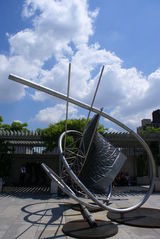
The Iris and B. Gerald Cantor Roof Garden is located on the roof towards the southwestern corner of the museum. It offers views of Central Park and the Manhattan skyline, and features an annual summertime single artist sculpture exhibition. The Garden's cafe and bar is a popular museum spot during the mild-weathered months, especially on Friday and Saturday evenings when large crowds can lead to long lines at the elevators
Special exhibitions
The museum regularly hosts notable special exhibitions, often focusing on the works of one artist that have been loaned out from a variety of other museums and sources for the duration of the exhibition.
History

The New York State Legislature granted the Metropolitan Museum of Art an Act of Incorporation on April 13, 1870 "for the purpose of establishing and maintaining in said City a Museum and Library of Art, of encouraging and developing the Study of the Fine Arts, and the application of Art to manufacture and natural life, of advancing the general knowledge of kindred subjects, and to that end of furnishing popular instruction and recreations".[27]
The museum first opened on February 20, 1872, housed in a building located at 681 Fifth Avenue in New York City. John Taylor Johnston, a railroad executive whose personal art collection seeded the museum, served as its first President, and the publisher George Palmer Putnam came on board as its founding Superintendent. The artist Eastman Johnson acted as Co-Founder of the museum. The former Civil War officer, Luigi Palma di Cesnola, was named as its first director.[28] He served from 1879 to 1904. Under their guidance, the Met's holdings, initially consisting of a Roman stone sarcophagus and 174 mostly European paintings, quickly outgrew the available space. In 1873, occasioned by the Met's purchase of the Cesnola Collection of Cypriot antiquities, the museum decamped from Fifth Avenue and took up residence at the Douglas Mansion at 128 West 14th Street. However, these new accommodations proved temporary, as the growing collection required more space than the mansion could provide.[29] After negotiations with the city of New York in 1871, the Met acquired land on the east side of Central Park, where it built its permanent home, a red-brick stone "mausoleum" designed by American architect Calvert Vaux and his collaborator Jacob Wrey Mould.[30] Vaux's ambitious building was not well-received; the building's High Victorian Gothic style was already going out of fashion by the time construction was completed, and the president of the Met termed the project "a mistake."[31] Within 20 years, a new architectural plan, incorporating the Vaux building solely as an interior and stripping it of many of its distinctive design elements, was already being executed. Since that point, a host of new galleries and architectural elements, including the distinctive Beaux-Arts facade, designed by architect and Met trustee Richard Morris Hunt and completed in 1902, have continued to expand the museum's physical structure, with the Vaux-designed structure completely surrounded by later additions. The Met's great entrance hall was also designed by Hunt, who died before it was finished. Hunt's son Richard Howland Hunt oversaw completion of the great hall to his father's specifications.[32]
As of 2010, the Met measures almost 1&fras1;4-mile (400 m) long and with more than 2,000,000 square feet (190,000 m2) of floor space, more than 20 times the size of the original 1880 building.[12] The museum building is an accumulation of 26 structures, most of which are not visible from the exterior. The City of New York owns the museum building and contributes utilities, heat, and some of the cost of guardianship.
The collections are owned by a private corporation of Fellows and Benefactors which totals about 1,630 persons. The museum is governed by a Board of Trustees consisting of 41 elected members, several officials of the City of New York, and persons honored as Trustees by the museum. The 2009-10 budget is $221 million, which calculates to $47 per visitor. The museum's endowment is very roughly $3 billion.[33]
On May 19, 2009, the Met re-opened its transformed American Wing, including a new presentation of 12 period rooms. One of the most dramatic changes was seen in the appearance of the Charles Engelhard Court, which has had a cafe overlooking Central Park added, as well as more internal glass windows.[34]
Acquisitions and deaccessioning
During the 1970s, under the directorship of Thomas Hoving, the Met revised its deaccessioning policy. Under the new policy, the Met set its sights on acquiring "world-class" pieces, regularly funding the purchases by selling mid- to high-value items from its collection.[35] Though the Met had always sold duplicate or minor items from its collection to fund the acquisition of new pieces, the Met's new policy was significantly more aggressive and wide-ranging than before, and allowed the deaccessioning of items with higher values which would normally have precluded their sale. The new policy provoked a great deal of criticism (in particular, from the New York Times) but had its intended effect.
Many of the items then purchased with funds generated by the more liberal deaccessioning policy are now considered the "stars" of the Met's collection, including Velázquez's Juan de Pareja and the Euphronios krater depicting the death of Sarpedon (which has since been repatriated to the Republic of Italy). In the years since the Met began its new deaccessioning policy, other museums have begun to emulate it with aggressive deaccessioning programs of their own.[36] The Met has continued the policy in recent years, selling such valuable pieces as Edward Steichen's 1904 photograph The Pond-Moonlight (of which another copy was already in the Met's collection) for a record price of $2.9 million.[37]
Controversies
An unauthorized book on the museum by the social historian Michael Gross was published in May, 2009, and caused a stir in museum, social and philanthropic circles. Initially titled Rogues' Gallery: The Secret History of the Moguls and the Money That Made the Metropolitan Museum, and reissued in paperback in May 2010 with a new subtitle, The Secret Story of the Lust, Lies, Greed and Betrayals That Made the Metropolitan Museum of Art, it focused on the personalities behind the museum, showcasing their personal peccadilloes and charting the relationship between the public and private behavior and ambitions of its trustees and benefactors and their cultural philanthropy. The book was banned in the Metropolitan's store,[38] its contents condemned by a museum spokesman as "misleading" and "insensitive,"[39] and a vice chairman of the museum's board, Annette de la Renta, whose family's relationship with the museum is covered at length in the book, threatened to sue Gross and publisher Random House over alleged inaccuracies in the text if the book was not withdrawn.[40] Publication proceeded and no lawsuit was filed. It was later alleged that the book had been briefly banned by the New York Public Library, where de la Renta also served on the board.[41] Subsequently, the New York Times Book Review described the book as "a blockbuster exhibition of human achievement and flaws," although it also criticized its focus on "lurid" matters unrelated to art.[42]
The museum has been criticized for withdrawing images of Muhammad from public display.[22][43]
This article is copied from an article on Wikipedia® - the free encyclopedia created and edited by online user community. The text was not checked or edited by anyone on our staff. Although the vast majority of the Wikipedia® encyclopedia articles provide accurate and timely information please do not assume the accuracy of any particular article. This article is distributed under the terms of GNU Free Documentation License.
Thanks to Encyclopedia The Free Dictionary / Farlex, Inc.
http://encyclopedia.thefreedictionary.com/p/Metropolitan%20Museum%20of%20Art
| To Get Uninterrupted Daily Article(s) / Review(s) Updates; Kindly Subscribe To This BlogSpot:- http://ZiaullahKhan.Blogspot.com/ Via "RSS Feed" Or " Email Subscription" Or "Knowledge Center Yahoo Group". | ||
| Amazon Magazine Subscriptions | Amazon Books | Amazon Kindle Store |
| Amazon Everyday Low Prices, Sales, Deals, Bargains, Discounts, Best-Sellers, Gifts, Household Consumer Products | ||



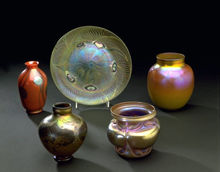
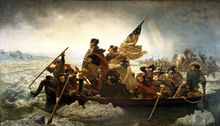
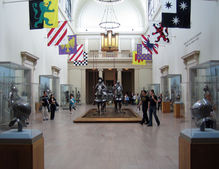
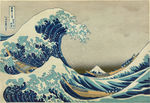
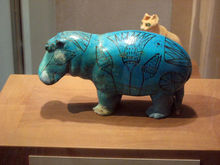
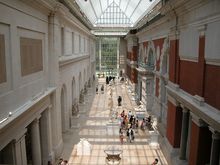
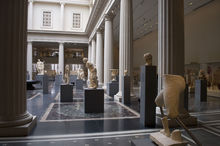
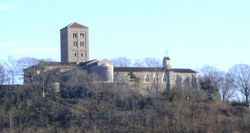
No comments:
Post a Comment